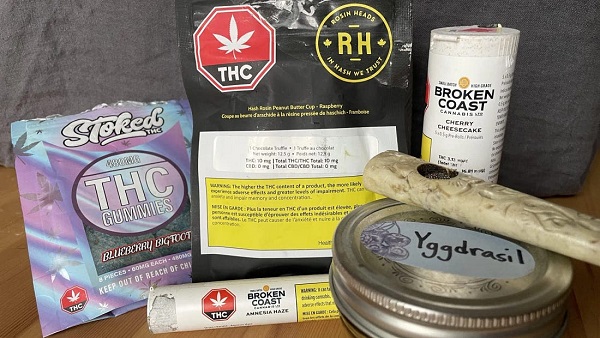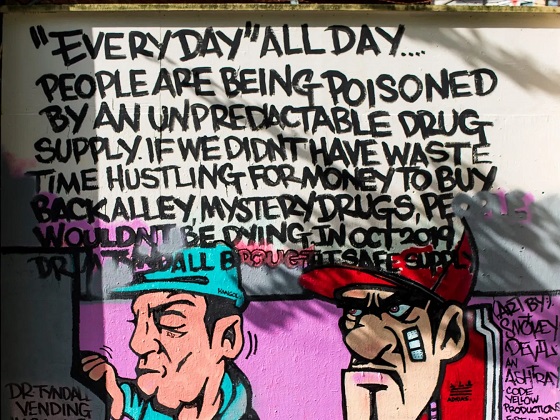Addictions
Fuelling addiction – The “safe supply” disaster

By Denise Denning
There is a growing schism in the Canadian addiction treatment community regarding safer supply.
[This article was originally published by the MacDonald Laurier Institute and has been syndicated with their permission]
As the death toll from the ongoing opioid poisoning crisis in Canada continues to rise, jurisdictions across the country struggle to find solutions. Safe consumption sites, where people can use drugs in a supervised setting that provides clean syringes and overdose kits, have opened across Canada. Addiction medicine clinics that provide treatments for drug use have proliferated nation-wide. Controversially, the Trudeau government has funded so-called “safer opioid supply” programs that provide powerful pharmaceutical opioids to people who use drugs with the presumption that they will use these in place of street drugs of unknown potency containing numerous and poorly understood toxic adulterants. But even though they lack those toxic adulterants, safer supply drugs are not safe. By virtue of the pharmacology inherent to all opioids, safer supply drugs may be increasing harm.
Unlike safe consumption sites, where people bring their own drugs and use them in a supervised environment, safer supply programs provide people who use opioids with up to 30 tablets per day of the powerful synthetic opioid hydromorphone to take away with them and use elsewhere without any supervision or proof that they are using the drugs themselves. “Safer supply services provide an alternative to the toxic illegal drug supply as a way to help prevent overdoses and can connect people to other health and social services,” touts Health Canada’s safer supply web page. Safer supply programs “build on existing approaches that provide medications to treat opioid use disorder” and these programs are “more flexible and do not necessarily focus on stopping drug use.”
Health Canada’s quietly optimistic tone is echoed and magnified by advocates and activists across the country, who insist that safer supply is “the most important intervention” to save the lives of people who use drugs and cite data suggesting that safer supply is a powerful harm reduction tool for helping people avoid the risks of exposure to sketchy street drugs. And the benefits of safer supply, proponents assert, go beyond saving people from overdose. Safer supply also protects people from the stigma associated with illicit drug use. “Overdose prevention measures that go beyond individual behaviour changes, including providing a safer supply of drugs and eliminating stigma, are paramount to mitigate harms,” asserts one review. “Increasing respectful treatment of people who use substances, and reducing stigma and trauma improves the health of communities,” a review of a drug checking service declares.
“Sociopolitical factors such as prohibition, stigma, and criminalization of people who use drugs have fuelled the current overdose crisis and toxic unregulated drug supply and limited the establishment and scale up of services for people who use drugs,” proclaims another paper promoting the benefits of safer supply.
Certainly, all of us working in addiction treatment agree that putting people in jail does not solve their drug use problems, and everyone should be able to access health care without concerns of being stigmatized. But suggesting that these factors have fuelled the current crisis is an assertion that not only lacks proof but also ignores the material reality of the pharmacology of these drugs and their impact on the human central nervous system.
There is a growing schism in the Canadian addiction treatment community regarding safer supply. Its opponents, who include prominent addiction medicine physicians across Canada, insist that none of the studies of safer supply consider the number of people in safer supply programs who sell or trade their safer supply drugs to buy fentanyl. They point out that the studies finding safer supply beneficial are too narrow in their scope because they only examine the benefits to the patients receiving the safer supply and do not consider diversion and its potential for harm by putting these drugs in the hands of people other than street drug users, such as youth, or people who have stopped using drugs.
In an article published by the Globe and Mail, addiction medicine physician and writer Dr. Vincent Lam wrote about how some of his patients are struggling with their addictions because the hydromorphone has become so cheap and readily available. “Patients of mine who were free of illicit opioids for years now struggle with hydromorphone, which they are buying from those to whom it is prescribed. One told me they prefer to sleep outside rather than in shelters, because they cannot avoid hydromorphone in the shelters. One who has never tried fentanyl – which hydromorphone is meant to protect them from – is injecting high doses of hydromorphone daily, struggling to get off, while their tolerance rapidly increases.”
Another critic of safer supply, Dr. Lori Regenstreif, has seen patients severely harmed when they crush and inject the tablets. “I’ve seen people become quadriplegic and paraplegic because the infection invaded their spinal cord and damaged their nervous system,” she said. And she called the studies in favour of safer supply “customer satisfaction surveys” that do not meet scientific standards of properly conducted research. For instance, a study that has been cited as powerful evidence for the effectiveness of safer supply did not control for patients using methadone or Suboxone, two well-established and effective treatments for opioid use disorder. At baseline, the control group and the study group were using these treatments at roughly the same rates. But the authors didn’t provide the number of participants using these treatments at the study’s end. So, the purported benefits of safer supply could have been from established treatments rather than safer supply.
A word about terminology: referring to these programs as “safer supply” is problematic because it implies that these programs are safe. Dr. Lori Regenstreif suggests the term “take home tablets” as a more neutral alternative that also describes exactly how these programs work. For the rest of this article, the term “take home tablets” or “prescribed opioids” will be used, only retaining “safer supply” in the previous paragraphs for the sake of clarity.
A review of 19 studies advocating for take home tablet programs found “no evidence demonstrating benefits.” For instance, only one of the studies recommended interventions that have been proven to address risk factors for addiction, even though all the studies found high rates of homelessness, unemployment, food insecurity, and other markers for poverty. And none of the studies investigated the implications of diversion, though there is increasing evidence that diversion is widespread. And a more recent review of these programs found that the “Safer Opioid Supply Policy” in British Columbia was associated with “a significant increase in opioid-related poisoning hospitalizations.”
The rhetoric is becoming increasingly heated and politicized. Supporters of take home tablet programs accuse its detractors of denying a potentially life-saving intervention to a vulnerable population of marginalized people. Critics, such as those discussed above, point to the paucity of good quality evidence and the plethora of potential harms from diversion. But what the discussion has been lacking is a consideration of how the pharmacology of these drugs should influence policies regarding the care provided to these marginalized and vulnerable people. Surely the way these drugs act in the human body should provide the underpinning for any evidence-based addiction management program.
Proponents of take home tablet programs will say, correctly, that opioids have been used for at least 3,000 years in the form of opium from Papaver somniferum, the poppy. Modern opioid pharmacology emerged out of the synthesis of morphine from opium in 1806. All opioids are derived from four compounds, including morphine, that are found in opium. Heroin is nothing more than morphine with a tweak to its molecule rendering it more fat soluble. Compared with water soluble substances, products that are fat soluble are better able to penetrate the blood brain barrier and enter the central nervous system. When heroin is injected, users experience a euphoric rush that they wouldn’t experience as intensely from injecting morphine, even though it’s almost the same drug as morphine, and within half an hour after injection, heroin is converted into morphine.
Stimulation of the opioid receptors by morphine and all its myriad opioid kin results in the classic effects of opioids such as pain relief, euphoria, sedation, respiratory depression, reduced heart rate, and a slowing of the gastrointestinal tract resulting in constipation. As the dosage is increased, respiration slows further, and patients sometimes experience nausea and vomiting. Depending on the dose taken and the person’s tolerance, increasing sedation may progress to coma and respiratory arrest. Opioids kill people by sedating them so deeply they stop breathing.
Subscribe for free to get Break The Needle’s latest news and analysis – or donate to our investigative journalism fund.
With chronic use, opioids cause adaptations in the body resulting in tolerance such that these habitual users require higher doses to achieve the same degree of euphoria. The flip side of tolerance is the withdrawal that happens when the person stops using and their autonomic nervous system goes into overdrive. The greater the tolerance, the worse the withdrawal, characterized by nausea and vomiting, diarrhea, muscle cramps, bone and joint aches, tremors, anxiety, goosebumps, sweating, restlessness. Opioid withdrawal isn’t generally fatal but may be if patients develop heart arrhythmias from electrolyte loss and autonomic overstimulation.
Tolerance and withdrawal are the evil twins of addiction. Addictive drugs have a rapid onset of action, produce a euphoriant effect, and have a short duration of action. The relative addictive potential of these drugs may be predicted by how much they adhere to these intersecting characteristics. For instance, morphine is less addictive than oxycodone, the active ingredient in OxyContin. Both morphine and oxycodone are rapid acting, produce euphoria, and have a short duration of action. Both may induce tolerance and withdrawal. But morphine gets metabolized to another substance that is more potent and sustains the opioid effect, and it accumulates if the person uses it every day. Morphine in effect has a longer duration of action compared with oxycodone, which has no active metabolites. A person who takes oxycodone will experience rapidly dropping blood levels as the drug is metabolized and excreted, leaving the user in withdrawal and craving more.
The manufacturers of the oxycodone product OxyContin infamously made a case for their product being less addictive because they formulated it into a long-acting dosage form that released the drug gradually over an 8-to-12-hour period. The story of OxyContin has been exhaustively covered elsewhere, and I won’t rehash it here. In brief: people quickly discovered that OxyContin’s sustained-release matrix could be easily defeated by chewing or crushing the tablets, thus releasing the drug all at once, and as knowledge of this hack spread, a growing public health crisis ensued, resulting in the destruction of communities, massive numbers of arrests as people seeking pain relief became criminalized by their addiction, and thousands of deaths across Canada and the United States.
The hydromorphone given to fentanyl users in safer supply programs is about five times stronger than morphine and four times stronger than oxycodone. It exerts its maximal effect in one to two hours and lasts for around three to four hours. In terms of relative addictiveness by virtue of its pharmacology, hydromorphone in theory would sit between heroin and fentanyl, though in a subset of a study called NAOMI, where people who use heroin were provided hydromorphone in place of heroin without their knowledge, none of the 25 participants could tell the difference.
Then there’s fentanyl. When injected, the onset of action for morphine and oxycodone is about 10 minutes. Injected fentanyl works almost immediately, and it is fat soluble, meaning that it can penetrate the blood-brain barrier and get into the brain with ease. The duration of action for morphine and oxycodone is similar, about 4 to 6 hours. Fentanyl’s duration of action is 30 to 60 minutes, maybe stretching to 2 hours if it’s injected intramuscularly rather than intravenously.
Fentanyl has a faster onset of action compared with other opioids, it produces a powerful euphoria by virtue of being about fifty times stronger than morphine, and its effects last about half as long at most. In other words, the public health disaster that has resulted from the widespread proliferation of fentanyl in the street drug supply could have been predicted from its pharmacology. Recall how people who use heroin could not distinguish it from hydromorphone. In contrast, fentanyl users prefer fentanyl because hydromorphone is not strong enough. There is increasing evidence, albeit anecdotal, that people who use fentanyl will sell their hydromorphone to other users reluctant to try the illicit drug supply. In turn, the pharmacology of these drugs predicts that those hydromorphone users may eventually transition to using fentanyl in search of a better high as their drug use continues and their opioid tolerance deepens.
Data published by Health Canada provides corroboration for this hypothesis. In 2016, fentanyl was implicated in 52 per cent of opioid toxicity deaths in Canada, while non-fentanyl opioids were present in 59 per cent of cases. By 2018, fentanyl and its analogues were present in 80 per cent of opioid toxicity deaths while non-fentanyl opioids had fallen to 46 per cent. As of 2024, fentanyl and its analogues were present in almost all opioid toxicity deaths while the prevalence of non-fentanyl opioids had fallen to 26 per cent.
If hydromorphone isn’t strong enough for fentanyl users, why not give them pharmaceutical fentanyl instead? But there are already stronger analogues of fentanyl, such as carfentanil, that are increasingly found when samples of illicit drugs are analyzed. A recent study discovered that 20 per cent of opioid-containing samples analyzed in Alberta in 2022 contained carfentanil. If drug dealers started losing customers to take home tablet programs (they currently are not), a potential arms race, where dealers increase the potency of their drugs to make them more attractive than legally available options, may result in an illicit drug supply of ever-increasing lethality. And what of the people who use these ultra-strong opioids? Obviously, more people will die. The potency of fentanyl means that people who use it find stopping using profoundly challenging. People working in addiction treatment struggle to help patients who are experiencing the worst withdrawal any of us have ever seen. If ultra-strong opioids dwarfing fentanyl in potency become predominant in the illicit drug supply, the people who survive using these drugs may be predicted to experience a withdrawal syndrome that approaches the limits of human misery.
And therein lies the harm of these drugs. Whether or not they are criminalized; whether people can freely access them, opioids are potent drugs with many significant side effects and long-term negative effects that worsen over time. People who use legitimately acquired opioids for therapeutic reasons struggle with chronic constipation, cognitive impairment, an increased risk of falls, paradoxical increased sensitivity to pain known as “opioid-induced hyperalgia,” and an ongoing risk of experiencing withdrawal if they are unable to access their medications. All drugs should be used in the context of balancing risks versus benefits, where the harms caused by side effects are balanced against the therapeutic benefits. Like pharmacologists David Juurlink and Matthew Herder said, “Put simply, high-dose opioids constitute a self-perpetuating therapy, with patients left vulnerable by the need for ongoing treatment to avoid withdrawal, itself a pernicious, drug-related harm.”
Comprehensive treatment aimed at recovery is the path forward
These problems are complex and multifaceted, involving intersecting domains of public health, law enforcement, and health care. My main objection to take home tablet programs, apart from the public health disaster to which these programs contribute, is the abandonment of the principle of eventual sobriety for people who use drugs. By giving people the drugs they want, we are giving up on the possibility of a better quality of life for a marginalized population of people, many of whom are self-medicating to deal with trauma that otherwise has been left unaddressed. Addiction is a chronic and long-standing condition marked by relapses. The main risk factors for addiction are mental illness and trauma. In particular, childhood abuse puts people at a magnified risk of having a substance use disorder as an adult. Women who engage in prostitution and use illicit drugs are more likely to have been sexually abused before the age of 15. These are traumatized people who are self-medicating to deal with psychological pain.
The key is to provide comprehensive treatment that aims at full recovery, but in a gradual way that makes use of gradated treatment pathways. This means that a prescribed supply of high potency opioids may be a useful tool for some people in their complex and long-standing journey to sobriety, if used as an adjunct to other treatments and supports. To minimize the risk of diversion, prescribers may use treatment agreements, documents that patients sign where they agree to take their medication as prescribed and not divert it, and submit urine drug screens if requested. But to offer take home tablets in the absence of evidence-based addiction treatment modalities and other psychosocial supports only serves to abandon people to ongoing severe intractable high potency opioid use.
What works for people caught in a web of seemingly intractable severe addiction? The two main treatment paradigms in addiction medicine have traditionally been abstinence-based programs such as the 12-step programs popularized by Alcoholics Anonymous, and harm reduction programs such as methadone maintenance treatment. Abstinence-based programs, as the name suggests, are defined by the all-or-nothing goal of total sobriety. These programs are attractive because of their “Kids, don’t do drugs” simplicity. But this simplicity is deceptive because addiction is complex, and these programs have been found not to work for most people. For instance, abstinence-based programs will frequently kick people out of treatment for using drugs, thus punishing them for the problems that motivated them to seek treatment in the first place. The focus on abstinence means that they minimize the reality that the journey to sobriety is punctuated by relapses. Current Canadian guidelines for the treatment of opioid use disorder warn against simple cessation of drug use without follow up because of the significant risk of overdose. When people stop using opioids, their tolerance wanes. If they relapse and use their former dose, they may suffer a fatal overdose.
The harm reduction treatment paradigm emerged out of the limitations of strict abstinence-based programs that eject patients who lapse, and that don’t offer gradated treatment pathways to gradually get patients to full recovery. Harm reduction accepts drug use with the overall goal, as the name suggests, of reducing the harms associated with using illicit drugs and retaining contact with those patients unwilling or unable to stop all drug use.
Harm reduction in the form of medication assisted treatments such as methadone, Suboxone and Sublocade has been the gold standard of opioid addiction treatment, effective in not only reducing illicit opioid use but also proven to reduce overdose risk, criminal behaviour, risky sexual behaviour, and the transmission of blood-borne infections propagated by needle sharing. Medication assisted treatments are also found improve people’s lives in the domains of social determinants of health, such as going back to school, finding employment, and regaining custody of children. And these programs have been proven to save lives, reducing mortality from overdose, suicide, alcohol, and even from causes one would not intuitively associate with drug use, such as cancer and cardiovascular disease. Medication assisted treatments are a resoundingly science-based harm reduction modality and should be the treatments of first choice offered to this vulnerable population.
But harm reduction is just one of the four pillars of addiction recovery. Harm reduction by itself saves lives, but it doesn’t help people move forwards towards sobriety. The other three pillars of addiction recovery are prevention, treatment, and enforcement. Prevention addresses the risk factors for addiction and involves treatment for mental illnesses and proper, more comprehensive pain management treatment plans that go beyond just prescribing painkillers. Enforcement means preventing these drugs or their precursors from entering Canada or prosecuting those who sell illicit drugs. And treatment for people who use drugs must involve not only just harm reduction, but also a comprehensive range of services such as housing supports, counselling and other psychosocial services, and employment support.
Take home tablet programs are based on two presumptions: firstly, that people receiving these drugs will use them in place of street drugs and not just sell them to buy street drugs, as they do; and secondly, that opioids are safe to take as long as the dose is not excessive. Given that these two presumptions are false, the only conclusion we can reach is that take home tablet programs do not reduce harm, but increase it. I concede that providing people with legally sourced opioids reduces their risk of criminal prosecution, and there is a reduction in stigma when you give people what they want without judgment, but this is a false dichotomy – you can achieve reductions in prosecution with better treatment, rather than supporting objectively harmful behaviour in the name of destigmatization. At the end of the day, stigma doesn’t kill people – bad drugs do, and providing people who use drugs with the wraparound supportive services that they need and have been shown to work is more complex, and probably more expensive. But complex problems are rarely solved by simple solutions.
Denise Denning is a correctional pharmacist with background in addiction treatment. After graduating from the University of Toronto Faculty of Pharmacy, Denning completed a specialized residency in the treatment of drug and alcohol use at the Addiction Research Foundation in Toronto (now CAMH). She worked as the pharmacist at the Toronto Jail for 17 years, and the pharmacy manager at the Toronto South Detention Centre for 8 years, where she provided clinical advice on the management of patients with opioid use disorder and supervised the preparation of methadone doses. She also worked part time for four years at a pharmacy providing mostly methadone in downtown Toronto. Currently, she is the provincial pharmacy manager for the Ontario Ministry of the Solicitor General, where she provides guidance on medication related policies and procedures for that province’s correctional facilities.
Subscribe to Break The Needle. Our content is always free – but if you want to help us commission more high-quality journalism, consider getting a voluntary paid subscription.
Addictions
Four new studies show link between heavy cannabis use, serious health risks

Cannabis products purchased in Ontario and B.C., including gummies, pre-rolled joints, chocolates and dried flower; April 11, 2025. [Photo credit: Alexandra Keeler]
By Alexandra Keeler
New Canadian research shows a connection between heavy cannabis use and dementia, heart attacks, schizophrenia and even death
Six months ago, doctors in Boston began noticing a concerning trend: young patients were showing up in emergency rooms with atypical symptoms and being diagnosed with heart attacks.
“The link between them was that they were heavy cannabis users,” Dr. Ahmed Mahmoud, a cardiovascular researcher and physician in Boston, told Canadian Affairs in an interview.
These frontline observations mirror emerging evidence by Canadian researchers showing heavy cannabis use is associated with significant adverse health impacts, including heart attacks, schizophrenia and dementia.
Sources warn public health measures are not keeping pace with rapid changes to cannabis products as the market is commercialized.
“The irony of this moment is that society’s risk perception of cannabis is at an all-time low, at the exact moment that the substance is probably having increasingly negative health impacts,” said Dr. Daniel Myran, a physician and Canada Research Chair at the University of Ottawa. Myran was lead researcher on three new Canadian studies on cannabis’ negative health impacts.
Legalization
Canada was the first G7 country to create a commercial cannabis market when it legalized the production and sale of cannabis in 2018.
The drug is now widely used in Canada.
In the 2024 Canadian Cannabis Survey, an annual government survey of cannabis trends, 26 per cent of respondents said they used cannabis for non-medical purposes in the past year, up from 22 per cent in 2018. Among youth, that number was 41 per cent.
Health Canada’s website warns that cannabis use can lower blood pressure and raise heart rates, which can increase the risk of a heart attack. But the warnings on cannabis product labels vary. Some mention risks of anxiety or effects on memory and concentration, but make no mention of cardiovascular risks.
The annual cannabis survey also shows a significant percentage of Canadians remain unaware of cannabis’ health risks.
In the survey, only 70 per cent of respondents said they had enough reliable information to make informed decisions about cannabis use. And 50 per cent of respondents said they had not seen any education campaigns or public health messages about cannabis.
At the same time, researchers are finding mounting evidence that cannabis use is associated with health risks.
A 2023 study by researchers at the University of Calgary, the University of Alberta and Alberta Health Services found that adults with cannabis use disorder faced a 60 per cent higher risk of experiencing adverse cardiovascular events — including heart attacks. Cannabis use disorder is marked by the inability to stop using cannabis despite negative consequences, such as work, social, legal or health issues.
Between February and April of this year, three other Canadian studies linked frequent cannabis use to elevated risks of developing schizophrenia, dementia and mortality. These studies were primarily conducted by researchers at the Ottawa Hospital Research Institute and ICES uOttawa (formerly the Institute for Clinical Evaluative Sciences).
“These results suggest that individuals who require hospital-based care for a [cannabis use disorder] may be at increased risk of premature death,” said the study linking cannabis-related hospital visits with increased mortality rates.
The three 2024 studies all examined the impacts of severe cannabis use, suggesting more moderate users may face lower risks. The researchers also cautioned that their research shows a correlation between heavy cannabis use and adverse health effects, but does not establish causality.
Subscribe for free to get BTN’s latest news and analysis – or donate to our investigative journalism fund.
Budtenders
Health experts say they are troubled by the widespread perception that cannabis is entirely benign.
“It has some benefits, it has some side effects,” said Mahmoud, the Boston cardiovascular researcher. “We need to raise awareness about the side effects as well as the benefits.”
Some also expressed concern that the commercialization of cannabis products in Canada has created a race to produce products with elevated levels of THC, the main psychoactive compound that produces a “high.”
THC levels have more than doubled since legalization, yet even products with high THC levels are marketed as harmless.
“The products that are on the market are evolving in ways that are concerning,” Myran said. “Higher THC products are associated with considerably more risk.”
Myran views cannabis decriminalization as a public health success, because it keeps young people out of the criminal justice system and reduces inequities faced by Indigenous and racialized groups.
“[But] I do not think that you need to create a commercial cannabis market or industry in order to achieve those public health benefits,” he said.
Since decriminalization, the provinces have taken different approaches to regulating cannabis. But even in provinces where governments control cannabis distribution, such as New Brunswick and Nova Scotia, products with high THC levels dominate retail shelves and online storefronts.
In Myran’s view, federal and provincial governments should instead be focused on curbing harmful use patterns, rather than promoting cannabis sales.
Ian Culbert, executive director of the Canadian Public Health Association, thinks governments’ financial interest in the cannabis industry creates a conflict of interest.
“[As with] all regulated substances, governments are addicted to the revenue they create,” he said. “But they also have a responsibility to safeguard the well-being of citizens.”
Culbert believes cannabis retailers should be required to educate customers about health risks — just as bartenders are required to undergo Smart Serve training and lottery corporations are required to mitigate risks of gambling addiction.
“Give ‘budtenders’ the training around potential health risks,” he said.
“While cannabis may not be the cause of some of these negative health events … it is the intersection at which an intervention can take place through the transaction of sales. So is there something we can do there that can change the trajectory of a person’s life?”
This article was produced through the Breaking Needles Fellowship Program, which provided a grant to Canadian Affairs, a digital media outlet, to fund journalism exploring addiction and crime in Canada. Articles produced through the Fellowship are co-published by Break The Needle and Canadian Affairs.
Our content is always free – but if you want to help us commission more high-quality journalism, consider getting a voluntary paid subscription.
2025 Federal Election
Study links B.C.’s drug policies to more overdoses, but researchers urge caution

By Alexandra Keeler
A study links B.C.’s safer supply and decriminalization to more opioid hospitalizations, but experts note its limitations
A new study says B.C.’s safer supply and decriminalization policies may have failed to reduce overdoses. Furthermore, the very policies designed to help drug users may have actually increased hospitalizations.
“Neither the safer opioid supply policy nor the decriminalization of drug possession appeared to mitigate the opioid crisis, and both were associated with an increase in opioid overdose hospitalizations,” the study says.
The study has sparked debate, with some pointing to it as proof that B.C.’s drug policies failed. Others have questioned the study’s methodology and conclusions.
“The question we want to know the answer to [but cannot] is how many opioid hospitalizations would have occurred had the policy not have been implemented,” said Michael Wallace, a biostatistician and associate professor at the University of Waterloo.
“We can never come up with truly definitive conclusions in cases such as this, no matter what data we have, short of being able to magically duplicate B.C.”
Jumping to conclusions
B.C.’s controversial safer supply policies provide drug users with prescription opioids as an alternative to toxic street drugs. Its decriminalization policy permitted drug users to possess otherwise illegal substances for personal use.
The peer-reviewed study was led by health economist Hai Nguyen and conducted by researchers from Memorial University in Newfoundland, the University of Manitoba and Weill Cornell Medicine, a medical school in New York City. It was published in the medical journal JAMA Health Forum on March 21.
The researchers used a statistical method to create a “synthetic” comparison group, since there is no ideal control group. The researchers then compared B.C. to other provinces to assess the impact of certain drug policies.
Examining data from 2016 to 2023, the study links B.C.’s safer supply policies to a 33 per cent rise in opioid hospitalizations.
The study says the province’s decriminalization policies further drove up hospitalizations by 58 per cent.
“Neither the safer supply policy nor the subsequent decriminalization of drug possession appeared to alleviate the opioid crisis,” the study concludes. “Instead, both were associated with an increase in opioid overdose hospitalizations.”
The B.C. government rolled back decriminalization in April 2024 in response to widespread concerns over public drug use. This February, the province also officially acknowledged that diversion of safer supply drugs does occur.
The study did not conclusively determine whether the increase in hospital visits was due to diverted safer supply opioids, the toxic illicit supply, or other factors.
“There was insufficient evidence to conclusively attribute an increase in opioid overdose deaths to these policy changes,” the study says.
Nguyen’s team had published an earlier, 2024 study in JAMA Internal Medicine that also linked safer supply to increased hospitalizations. However, it failed to control for key confounders such as employment rates and naloxone access. Their 2025 study better accounts for these variables using the synthetic comparison group method.
The study’s authors did not respond to Canadian Affairs’ requests for comment.
Subscribe for free to get BTN’s latest news and analysis – or donate to our investigative journalism fund.
Correlation vs. causation
Chris Perlman, a health data and addiction expert at the University of Waterloo, says more studies are needed.
He believes the findings are weak, as they show correlation but not causation.
“The study provides a small signal that the rates of hospitalization have changed, but I wouldn’t conclude that it can be solely attributed to the safer supply and decrim[inalization] policy decisions,” said Perlman.
He also noted the rise in hospitalizations doesn’t necessarily mean more overdoses. Rather, more people may be reaching hospitals in time for treatment.
“Given that the [overdose] rate may have gone down, I wonder if we’re simply seeing an effect where more persons survive an overdose and actually receive treatment in hospital where they would have died in the pre-policy time period,” he said.
The Nguyen study acknowledges this possibility.
“The observed increase in opioid hospitalizations, without a corresponding increase in opioid deaths, may reflect greater willingness to seek medical assistance because decriminalization could reduce the stigma associated with drug use,” it says.
“However, it is also possible that reduced stigma and removal of criminal penalties facilitated the diversion of safer opioids, contributing to increased hospitalizations.”
Karen Urbanoski, an associate professor in the Public Health and Social Policy department at the University of Victoria, is more critical.
“The [study’s] findings do not warrant the conclusion that these policies are causally associated with increased hospitalization or overdose,” said Urbanoski, who also holds the Canada Research Chair in Substance Use, Addictions and Health Services.
Her team published a study in November 2023 that measured safer supply’s impact on mortality and acute care visits. It found safer supply opioids did reduce overdose deaths.
Critics, however, raised concerns that her study misrepresented its underlying data and showed no statistically significant reduction in deaths after accounting for confounding factors.
The Nguyen study differs from Urbanoski’s. While Urbanoski’s team focused on individual-level outcomes, the Nguyen study analyzed broader, population-level effects, including diversion.
Wallace, the biostatistician, agrees more individual-level data could strengthen analysis, but does not believe it undermines the study’s conclusions. Wallace thinks the researchers did their best with the available data they had.
“We do not have a ‘copy’ of B.C. where the policies weren’t implemented to compare with,” said Wallace.
B.C.’s overdose rate of 775 per 100,000 is well above the national average of 533.
Elenore Sturko, a Conservative MLA for Surrey-Cloverdale, has been a vocal critic of B.C.’s decriminalization and safer supply policies.
“If the government doesn’t want to believe this study, well then I invite them to do a similar study,” she told reporters on March 27.
“Show us the evidence that they have failed to show us since 2020,” she added, referring to the year B.C. implemented safer supply.
This article was produced through the Breaking Needles Fellowship Program, which provided a grant to Canadian Affairs, a digital media outlet, to fund journalism exploring addiction and crime in Canada. Articles produced through the Fellowship are co-published by Break The Needle and Canadian Affairs.
Our content is always free – but if you want to help us commission more high-quality journalism,
consider getting a voluntary paid subscription.
-

 Alberta2 days ago
Alberta2 days agoPremier Danielle Smith responds to election of Liberal government
-

 2025 Federal Election2 days ago
2025 Federal Election2 days agoIn Defeat, Joe Tay’s Campaign Becomes a Flashpoint for Suspected Voter Intimidation in Canada
-

 Banks1 day ago
Banks1 day agoTD Bank Account Closures Expose Chinese Hybrid Warfare Threat
-

 2025 Federal Election1 day ago
2025 Federal Election1 day agoPost election…the chips fell where they fell
-

 Alberta1 day ago
Alberta1 day agoNew Alberta Election Act bans electronic vote counting machines, lowers threshold for recalls and petitions
-

 Alberta1 day ago
Alberta1 day agoHours after Liberal election win, Alberta Prosperity Project drumming up interest in referendum
-

 2025 Federal Election2 days ago
2025 Federal Election2 days agoPoilievre loses seat but plans to stay on as Conservative leader
-

 COVID-191 day ago
COVID-191 day agoFreedom Convoy leaders’ sentencing judgment delayed, Crown wants them jailed for two years





